Pathways to Progress
An Overview of Force Development for Aviation Ordnance
Navigating the Marine Corps' force development system can be daunting, but understanding the pathways to change is essential for driving meaningful improvements. Whether addressing urgent operational needs, deliberate capability development, or aligning with mission essential tasks (METs), each process serves as an inroad to influence organizational change. This guide highlights key mechanisms—U-UNS, D-UNS, JEONs, JUONs, CBAs, AARs, and METs—and their potential to effect positive change, particularly in the aviation ordnance community. This article aims to provide a foundational understanding of these tools and their roles within the broader capability development framework. While this overview is not exhaustive, it will guide readers toward identifying relevant pathways and encourage further exploration of these topics.
If you're already familiar with these instruments, I recommend checking out the USMC Force Development User Guide for an in-depth look at how these components work together.
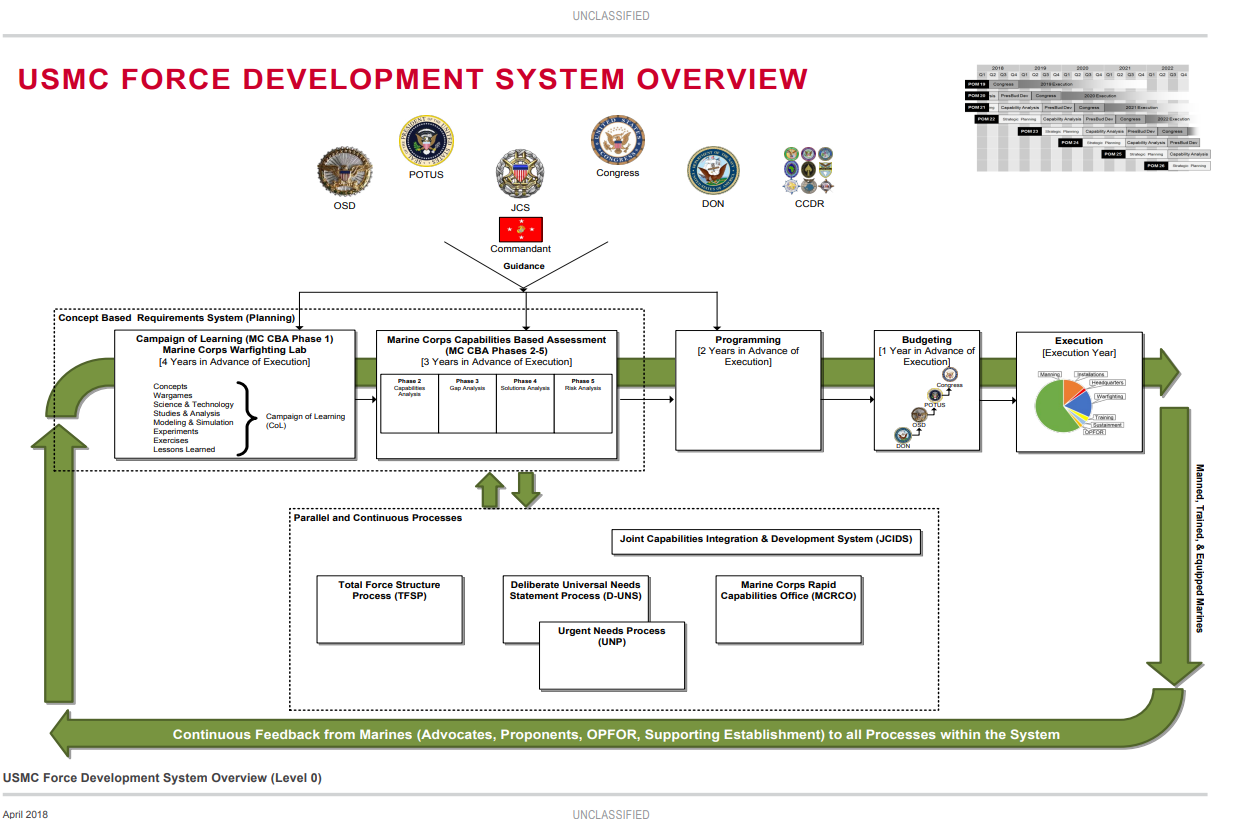
The Role of After Action Reports (AARs)
At first glance, After Action Reports (AARs) may appear sufficient for identifying operational shortfalls, but they are not inherently designed to define capability gaps or establish formal capability requirements. As outlined in MCO 3504.1A, the Marine Corps Lessons Learned Program (MCLLP) systematically catalogs lessons learned to inform operational planning, training, and resource allocation. Specifically, "lessons learned are used by leaders at every echelon to inform operational planning and execution; improve training and education; support combat development; inform safety programs during the identification of hazards, assessment of risks, and implementation of safety controls; support materiel acquisition and life-cycle management; and inform resource allocation decision-making."
In this context, AARs play a crucial role within the MCLLP as one of several tools for documenting observations. Additional document types—such as tactical demonstration (TACDEMO) reports, exercise “hot wash” briefs, Marine Corps Combat Readiness Evaluations (MCCRE) assessments, and other supporting materials—are similarly essential for the program’s comprehensive approach to discovery. These inputs can capture operational nuances and help validate trends or lessons that might otherwise be missed.
When incorporated into the MCLLP, AARs serve as a vital mechanism for raising awareness of specific shortfalls and supporting materiel acquisition efforts. However, it is critical to recognize that AARs are not standalone drivers of change. While they provide valuable insights and evidence, shortfalls identified in an AAR do not directly initiate acquisition processes, establish capability requirements, or justify programmatic decisions. These limitations underscore the importance of submitting AARs to TECOM to maximize their utility. Per MCO 3504.1A, active component organizations and units must submit AARs, along with supporting materials, within 30 days of completing operations, deployments, major exercises, MCCREs, or Service Level Training Events. Failure to do so effectively nullifies their contribution to the broader process.
Importantly, AARs and related materials submitted to TECOM are analyzed for inclusion in the annual Marine Corps Capabilities-Based Assessment (CBA). This analysis is integral to the force development process, as the CBA identifies capability gaps and recommends approaches to address them through DOTmLPF-P changes, materiel acquisition, or other initiatives. While AARs themselves are not sufficient to drive formal changes, their inclusion in the MCLLP ensures they are systematically evaluated and can inform the Campaign of Learning.
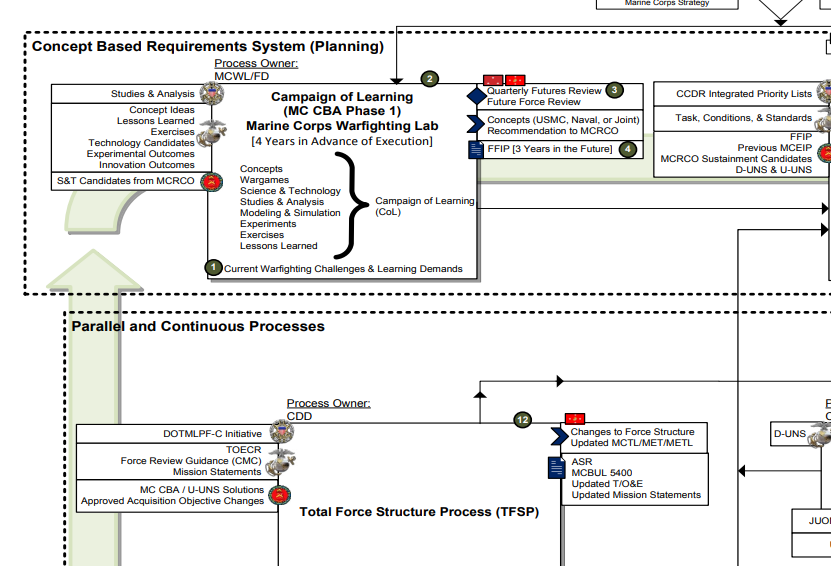
In summary, AARs and similar reports are instrumental in highlighting operational shortfalls but are not sufficient as standalone justifications for materiel or DOTmLPF-P changes. Instead, they function as supporting tools that strengthen and justify formal capability requirement documents, such as Urgent Universal Need Statements (U-UNS), DOTmLPF-P Change Recommendations (DCRs), and Initial Capability Documents (ICDs). For instance, a well-documented AAR can provide essential evidence supporting the need for a Capabilities-Based Assessment (CBA), which may, in turn, drive the development of one or more ICDs or DCRs through the JCIDS process. By submitting AARs into the MCLLP, units ensure that identified issues contribute to the broader framework for Marine Corps Force Development.
Capabilities-Based Assessment (CBA)
A Capabilities-Based Assessment (CBA) is a crucial step in the Joint Capabilities Integration and Development System (JCIDS), providing a structured approach to analyze mission areas and identify the capabilities and capacities required to meet operational needs. Specifically, a CBA evaluates current capability gaps and suggests either materiel (hardware or software) or non-materiel (changes in processes or policies) solutions. This process helps ensure that future capabilities are not only effective but also feasible and aligned with strategic objectives. modification of existing ones.
The CBA process offers a detailed, methodical framework for understanding the shortfalls within existing capabilities. This makes it a valuable tool for identifying gaps in both materiel and DOTmLPF-P (Doctrine, Organization, Training, Materiel, Leadership and Education, Personnel, Facilities, and Policy). By assessing and documenting the shortfalls in these areas, the CBA creates the groundwork for subsequent development efforts, and lays the groundwork for capability requirement documents.
Outputs of a CBA
- Initial Capabilities Document (ICD):
- If a materiel solution is recommended, the ICD outlines the identified gaps, proposed solutions, and the Concept of Operations (CONOPS) for the integration of these new capabilities.
- DOTmLPF-P Change Recommendation (DCR):
- If the solution is non-materiel, a DCR is produced. This document recommends changes across the DOTmLPF-P spectrum to address the identified capability gaps.
Unlike the annual Marine Corps Capabilities-Based Assessment (MC CBA), a standalone CBA can be initiated at any time, allowing for the timely and focused examination of critical issues with the necessary level of detail and precision.
To learn more about CBA's, see Capabilities-Based Assessment (CBA).
Urgent Needs Process (U-UNS, JUONs, JEONs)
The Urgent Needs Process (UNP) is designed to address immediate, mission-critical capability gaps by rapidly providing solutions. This process synchronizes abbreviated requirements, resourcing, and acquisition procedures to fulfill urgent operational needs that, if left unresolved, could lead to mission failure or increased risk to personnel. While the UNP prioritizes speed, it may accept reasonable risks regarding DOTmLPF-P integration and sustainment.
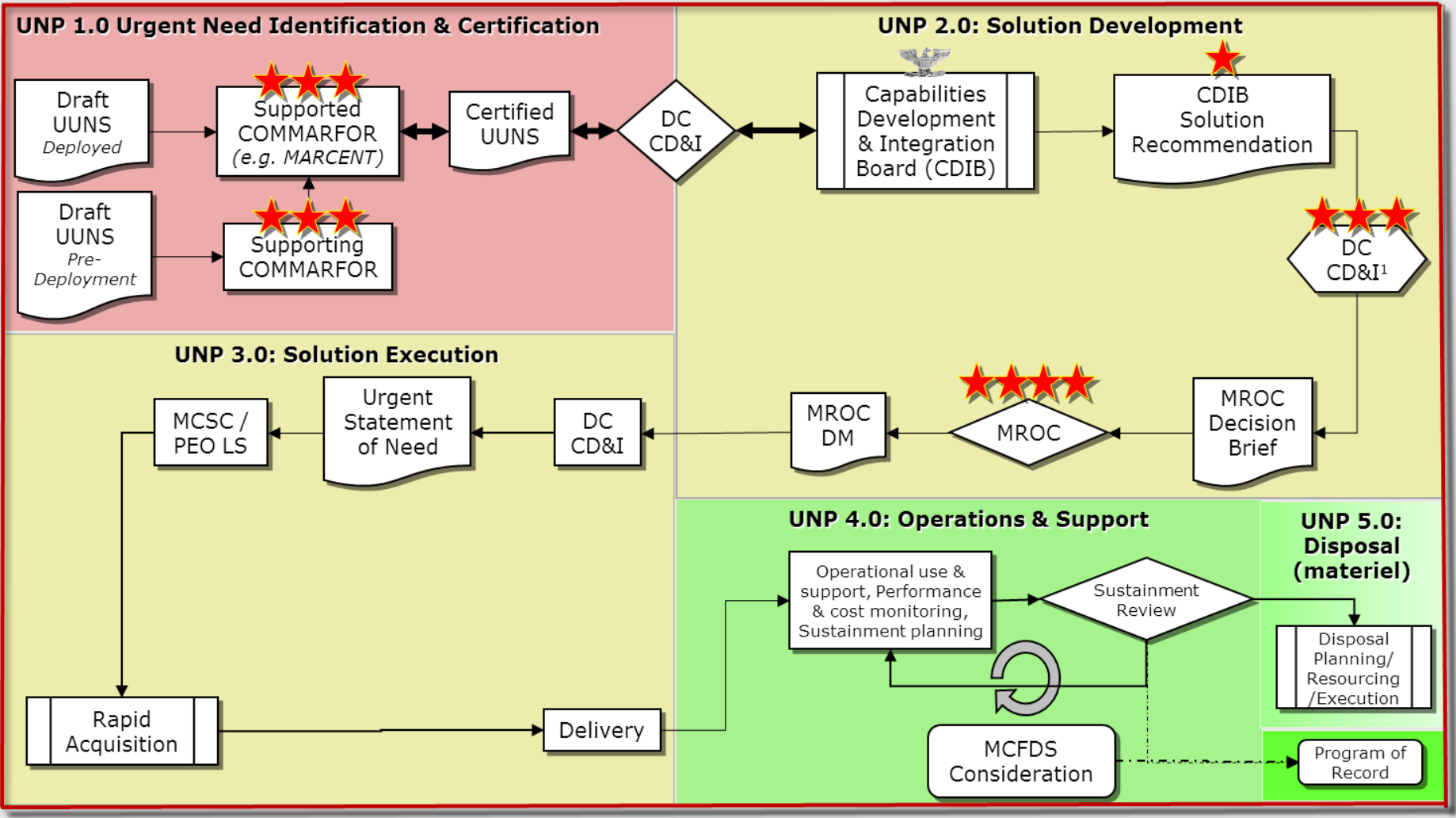
Within the Urgent Needs Process, there are three specific categories of needs:
-
Urgent Universal Needs Statement (U-UNS): This Marine Corps specific process aims to field a capability as quickly as possible, often within two years, to address immediate needs.
-
Joint Urgent Operational Needs (JUONs): These are UONs identified by a Combatant Command (CCMD), the Chairman of the Joint Chiefs of Staff (CJCS), or the Vice Chairman of the Joint Chiefs of Staff (VCJCS) as inherently joint and impacting an ongoing contingency operation.
-
Joint Emergent Operational Needs (JEONs): These are UONs identified by a CCMD, CJCS, or VCJCS as inherently joint and impacting an anticipated contingency operation.
In the Marine Corps, JUONs and JEONs are typically assigned to the service by the Joint Rapid Acquisition Cell (JRAC) via the Department of the Navy (DoN). The JRAC maintains visibility of DoD component efforts to satisfy Urgent Operational Needs (UONs) and informs the Warfighter Senior Integration Group (SIG) of the status of JUON/JEON funding, contracting, delivery, and sustainment.
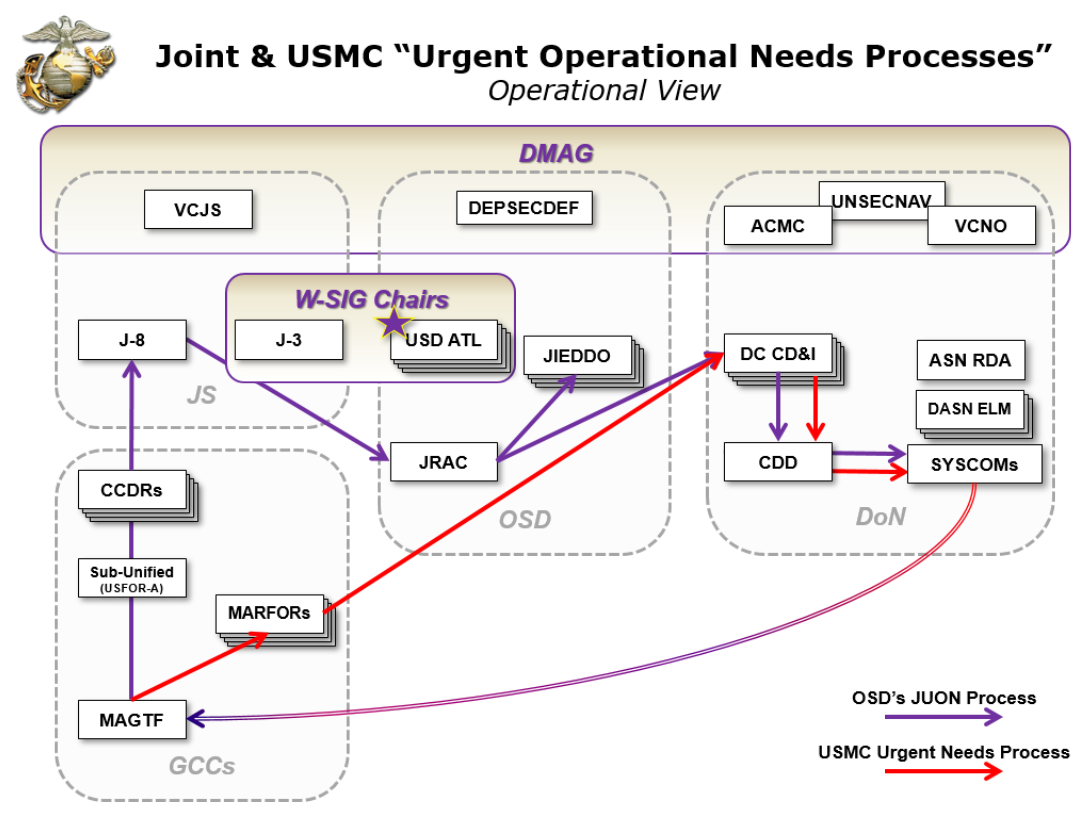
However, these rapid solutions may have DOTmLPF-P deficiencies due to the expedited process. To develop enduring solutions, all U-UNS are eventually transitioned into the Deliberate Universal Needs Statement (D-UNS) process. This transition allows for comprehensive analysis during the Marine Corps Capabilities-Based Assessment (MC CBA) to identify and address capability gaps, ensuring that the resulting solutions are sustainable and integrated across all DOTmLPF-P domains.
Where do I Start?
Start by taking a look at the resources on the CD&I Urgent Needs Process page, such as the U-UUNS Template. There's a pretty good set of information available to you on this site and within MCO 3900.17 to get you started on the right track. Inevitably, you'll have some questions. Embedded within the G-9 at each MAW, MEF, and MARFOR resides an UNP representative who can answer your specific inquires and assist in the routing process.
For more information, see Urgent Needs Process & D-UNS
Deliberate Universal Needs Statement (D-UNS)
A D-UNS is a formal document that is used to enter the annual Capabilities-Based Assessment (CBA) within the Marine Corps Force Development System, known as the MC CBA. Unlike the Urgent Universal Needs Statement (U-UNS), described above, the D-UNS follows a more methodical approach and focuses on deliberate, comprehensive development and integration.. It recommends changes such as developing new capabilities, enhancing existing ones, or eliminating redundant actions. This process allows for comprehensive development, integration across Doctrine, Organization, Training, materiel, Leadership and Education, Personnel, and Facilities, and Policy (DOTmLPF-P), and prioritization relative to other capabilities and available resources.
Upon submission, the D-UNS enters a competitive evaluation with the other submissions. It must be prioritized and integrated into the Marine Corps Capabilities-Based Assessment (MC CBA). If a D-UNS is deemed urgent by DC CD&I, it may be expedited through the U-UNS process. Typically the D-UNS process results in a the development of a new capability, which may take two to three years to materialize, depending on its success in the prioritization process.
For more information, see Urgent Needs Process & D-UNS
Mission Essential Tasks (METs)
I'd recommend reading MCTL, METs, and METL prior to reading this section, I make very little effort to explain these concepts below and you should arrive with a foundational understanding prior.
The Role of METs in Force Development
According to MCO 3500.110, "Mission Essential Tasks (METs) provide the foundation for the establishment of training priorities and the reporting of unit readiness to support combatant commanders for joint operations." It also emphasizes that, "The METL serves as the capstone list, translating the commander’s mission analysis into tangible training objectives and assessment criteria against which to measure readiness." The Total Force Structure process is designed to align resources with the Commandant's priorities, ensuring a balance and capable force. It plans and implements changes to the force structure, building capability-based organizations that accurately represent the total requirements for billets and equipment necessary to accomplish the Marine Corps' METs.
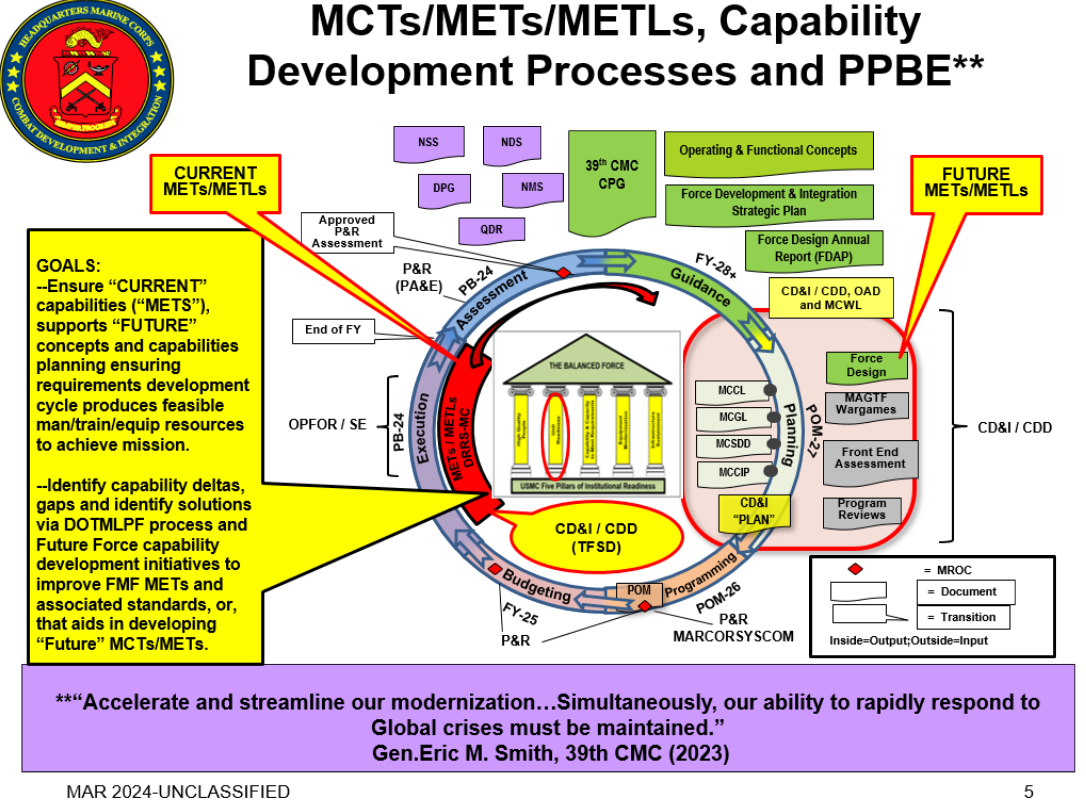
This clearly shows that force structure is designed around the accomplishment of METs. So, why doesn’t the aviation ordnance community have relevant METs assigned to a flying squadron? At the squadron level, much of what we do is implicit.
MCO 3500.110 provides some context: "An essential task is an externally focused action, process, or activity deemed critical to mission accomplishment." Moreover, a MET typically supports another command or directly affects the enemy—tasks like defending against an enemy or providing medical support to another organization. For a flying squadron, assigning a MET like "Perform loading of precision guided munitions on aircraft" might seem out of place. Perhaps such a MET would be more suited to an external squadron or unit with a mission focused on enabling the expeditionary maneuver of the ACE—but that's a discussion for another time. Does this mean aviation ordnance doesn't need METs? Absolutely not.
The aviation ordnance community should seek to embed itself within the conditions and standards of existing METs, particularly those associated with "Conduct Strike" and other operational tasks. For instance, how many Quality Assurance Safety Observers (QA/SOs) are necessary? Operating at how many dispersed sites? What types and quantities of handling equipment must be ready for issue (RFI) at the squadron? All of these factors become reportable material within DRRS (Defense Readiness Reporting System), holding the commander accountable.
Without the framework of METs, we risk continuing the mindset of "we'll get it done somehow, as we always have," potentially sacrificing operational efficiency—or worse, mission success or safety.
While it’s clear that flying squadrons might not require METs for internal functions, what about assault support squadrons that perform critical logistics functions within the adversary's weapon engagement zone (WEZ)? What kind of equipment do they need, how many sorties should they be able to support, and how fast do they need to operate?
There are numerous opportunities for the aviation ordnance community to break free from implied tasks and harness the full benefits of the Total Force Structure Management System (TFSMS) by developing clear, detailed METs that are essential for mission success.
Force Structure is Directly Driven by METs: "Force structure represents the total requirement in terms of units, billets, and equipment necessary to accomplish USMC METs."
Once METs are established or conditions and standards are modified, DC CD&I, in coordination with the MAGTF Advocates and Proponents, will develop the force structure necessary to support them. This includes both billets and equipment. The force structure development process involves a mission-function-task analysis, using SMEs to determine the necessary skills (by grade and quantity) and the required equipment (by TAMCN and quantity) to complete the mission.
The Bottom Line
Without clearly defined METs, there is no solid foundation to advocate for additional resources, personnel, or equipment. If our community continues to operate with implied tasks and lacks concrete METs, our advocacy efforts will be similarly dismissed. To avoid this, it’s crucial to establish explicit METs that clearly define conditions and standards for aviation ordnance tasks, providing the foundation for future resource allocation outside of our own vacuum.
For a detailed examination of the evidence supporting the points above, please refer to The Overwhelming Case for METs.
References
- Ammunitica - MCTL, METs, and METL
- Ammunitica - The Overwhelming Case for METs
- Ammunitica - Urgent Needs Process & D-UNS
- Ammunitica - Capabilities-Based Assessment (CBA)
- Ammunitica - Capability Requirement Documents
- DAU - Capabilities Based Assessment (CBA)
- Force Development System User Guide
- MCO 3900.20, Marine Corps Capabilities-Based Assessment
- MCO 5311.1E, Total Force Structure Process
- MCO 3500.110, Marine Corps Task List (MCTL), Mission Essential Tasks (MET), and Mission Essential Task List (METL) Process
- MCO 3900.17, Urgent and Deliberate Universal Needs Statement Process